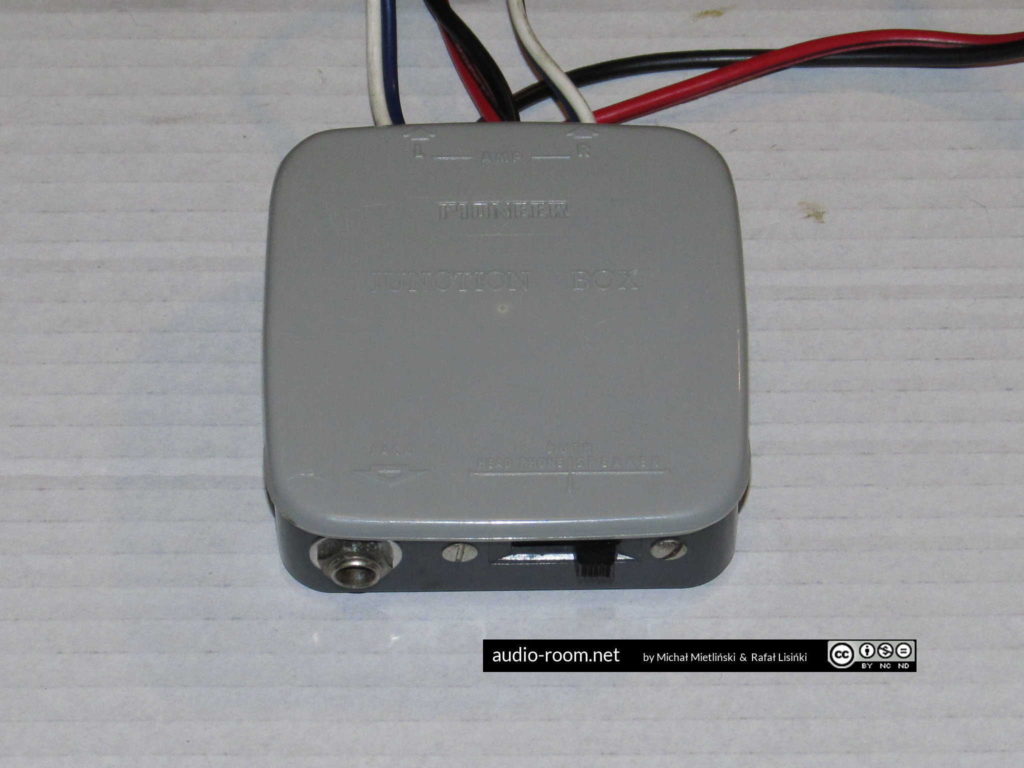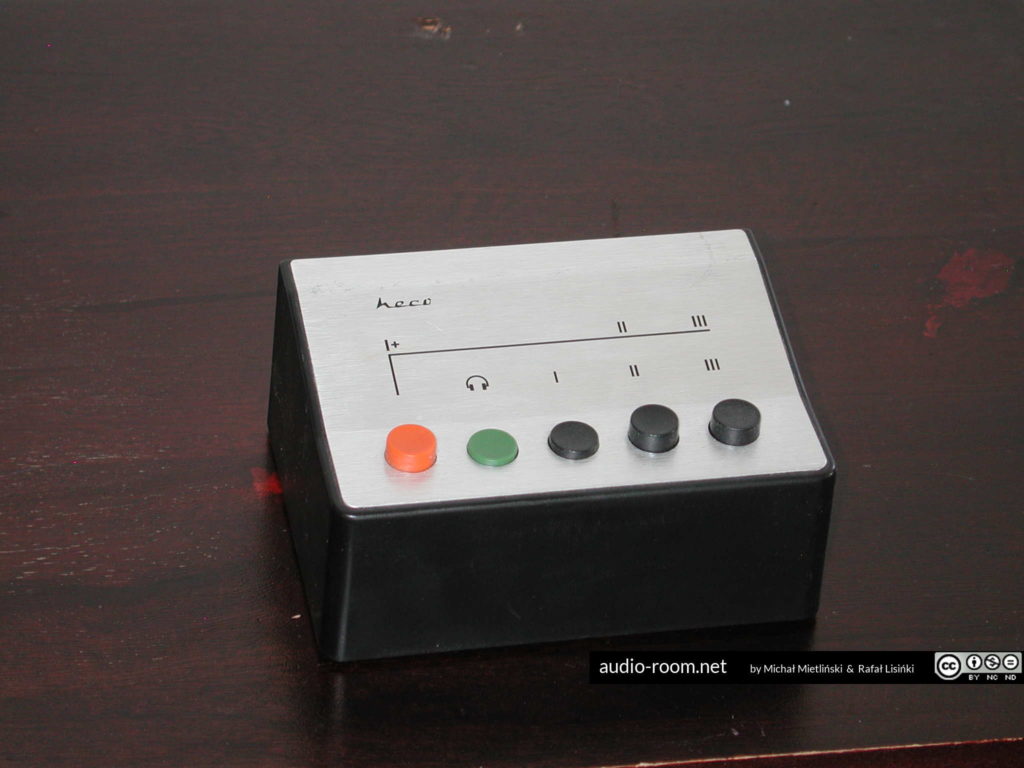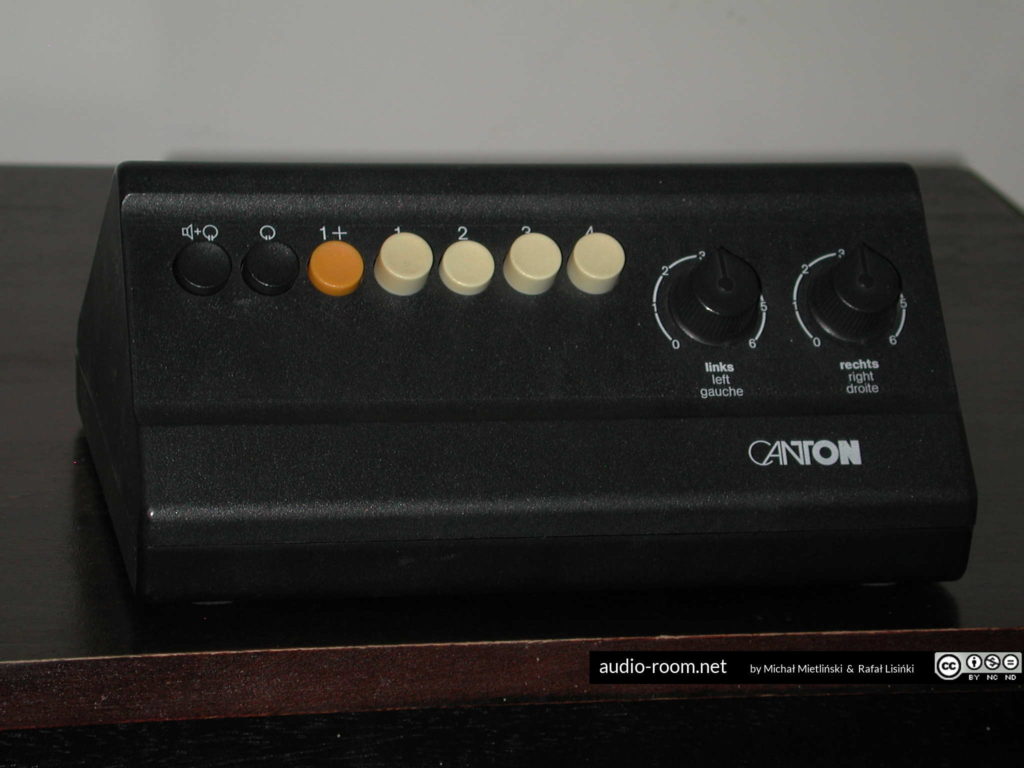You want to use headphones but your amp does not have nice little hole to plug them into? Well, few of mine sure don’t, including some of my all-time favorites like Exposure Super XX or Cyrus One. Neither do many power amps, or their matching preamps for that matter. That’s not the end of the world though, the solution to this problem was ready decades before these amps were made.
In most amps and receivers, especially those from the 20th century, the signal for the headphone jack is taken from the amp’s outputs via a simple voltage divider circuit that usually consists of 2 resistors per channel. The reasons for this solution are that it’s as simple and as cheap as it gets. You take the amplified signal you already have (for speaker outputs) and drop it to the level that headphones can handle. 2 resistors per channel are all it takes to do that.
Now, say you have one of those amps that don’t have headphone sockets. What prevents you from connecting a similar circuit to the amp’s speaker outputs? In most cases absolutely nothing! You don’t even have to tinker yourself either, several manufacturers have already done that for you. Good news: you can still use speakers whenever you want (well, in most cases).

Pioneer JB-21 is the oldest and simplest such device I could find. It was manufactured in the late 1960 and early 1970s. “JB” stands for “junction box”. It has one pair of wires that you connect to the amp’s speaker outputs, one pair of speaker outputs to connect your speakers to, a 6.3 mm headphone socket and a switch that allows you to select speakers, headphones or both. It is also very simple inside: there are only 4 resistors, two of them (8 ohm) are wired to common ground, the other two (100 ohm) are wired in series to headphone connector + (one per channel).

Heco UT 3 is German and a bit later than the Pioneer box, the earliest mention I’ve found is in 1974 catalogue, and it was still being made in 1981. “UT” stands for “Umshalt Tastatur”, which is German for ” switching keyboard”. Typically for German devices from that period it has DIN speaker wire sockets and headphone socket, but there’s a regular 6.3 socket too. This box gives you more possibilities: in addition to headphones you can connect not one, but three pairs of speakers and select headphones only, speakers only or both. You can also select either one pair of speakers or the pair connected to sockets “I” and either of speakers connected to sockets “II” or “III”. Inside there are 6 resistors, the extra two (2.5 ohm) resistors are wired to speaker sockets and used for impedance matching if you select more than one pair of speakers. The divider is stronger than in the Pioneer, resistors are 385 ohm (+) and 68 ohm (common ground).

Canton Connect 50 is German too. Like the Heco box, it comes from the mid-70s and was part of the line designed to march the style of Braun receivers. Canton made a number of similar switchers, under the names Connect and Combi. Connect 50 is more complex still, it has all the functions of the Heco box plus connectors for one more set of speakers (you can connect 4 pairs total, but still use only two at the same time), and pots that attenuate the level of speakers 2, 3 and 4. Like in the Heco box, speaker connectors are DIN, headphone sockets are DIN and 6.3 mm. Internally it’s the same as Heco – 6 resistors, four form a divider circuit for headphones, two (2 ohm) are wired to speaker sockets. The divider is different again, resistors are 47 ohm (+) and 780 ohm (common ground).
I tested these 3 devices without any problems (other than a few switches that got noisy over the years and needed cleaning) with a number of amps and headphones. They are easy to connect, use, and they work as they should.

Mission Cyrus One without headphone jack, with TDS Amfiton headphones
connected via Pioneer JB-21.
The above devices come from the 70s (more or less), but there is a modern a modern alternative for those who believe that new means better. The device is called Can Opener and it is based on the same principle. It is a divider network made of 4 resistors is a box, with nicer speaker wire connectors to connect to your amp, and a better quality headphone socket. Can Opener does not have speaker output connectors, so if you use it, you can’t use your speakers without shuffling cables. And it costs around $50 (used) – $80 (new). That’s for 4 resistors in a box. The above 3 boxes give you more connection possibilities and come about 4 times cheaper.
Now to the important question: how does it sound? Well, it’s just resistors, sockets and wires in a box, so it sounds just as good or as bad as your amp does. It doesn’t magically improve or spoil the sound, it is a simple convenience. It allows you to connect you headphones to an amp without a headphone socket, and, in the case of the Heco and Canton, connect more speakers too. One thing it does improve: If you have a modern amp that has a separate headphone amplifier circuit and that circuit can’t handle high impedance headphones – these boxes sure will. I tested it with Yamaha AP-U70 amplifier and Sennheiser HD 555 headphones – Senns connected to the Yamaha’s headphone socket sounded weak, connected to the speaker outputs via Heco UT 3 they sounded great.
One thing to keep in mind is that British manufacturers have a reason not to fit headphone jacks in their amps, and it’s not cutting costs. While resistors themselves should not cause any sound degradation, there are other parts that might: additional switches, connectors, wires are all in the signal path if you add a headphone jack. External headphone jacks like the three above also have these parts and may cause the same signal loss. In many systems the effects would be negligible, but in better systems they might be audible. So it’s best to compare the system’s sound with and without such device, and if it affects the sound, use only when needed or remove before serious listening.
A word of warning: all these boxes have common ground. There are amplifiers, especially T-amps and some tube amps, that will hum, distort or even blow if you short grounds of two channels. When in doubt, check if your amp has common ground. If it does, you can safely use one of these boxes. If it doesn’t, best not risk it.
Gallery PIONEER JB-21
Gallery HECO UT 3
Gallery CANTON CONNECT 50






















Pingback: how to connect headphones to tv without headphone jack – Gotvall
I just bought a 1978 Pioneer SX-780. It is beautiful but the headphone jack receptacle is noisy. Any reason why one of the three devices you discussed would not allow me to successfully use my headphones without having to have the headphone jack receptacle repaired? Thx for any thought you would be willing to share.
I would have to know more about the kind of noise you have and about your headphones to diagnose the problem with certainty, but the two most common noise issues of headphone jacks in vintage receivers are:
1. crackles, intermittent sound when connecting headphones and/or while listening; the noise may change or even disappear for a while when you move/twist the headphone plug in the socket
2. background noise (it can be hum or white noise) present all the time, with intensity that may but does not have to increase as you increase volume.
The first issue is usually due to a problem with the headphone socket itself, in most cases dirty/corroded contacts inside the socket. Cleaning these contacts or replacing the socket will fix the problem. Also, in such case, yes, you can use a “can opener” instead of repairing the socket and you should not have a noise problem.
The second issue is a result of how the amp’s designed. Most amps and receivers, especially those from the 1970s, draw the signal for headphones from the amp’s speaker outputs. That signal is simply reduced from speaker level to headphone level by resistors. It is the same solution as the one used in “can openers”. The problem is that most amps have some background noise. In most cases, the amount of that noise is too small to be a nuisance when you use the amp with speakers, or with headphones that the amp was designed to work with. Headphones from the 1970s usually had high impedance and low efficiency, they needed stronger signal to generate sound. With such headphones, amp’s background noise is inaudible or very quiet. But many modern headphones are designed for much weaker signal from mobile devices and have completely different specs than headphones from the 1970s. This means that you will hear much more background noise if you use efficient modern headphones. If that is the problem with your Pioneer SX-780 and your headphones, a “can opener” will not help at all, because it works just like the headphone socket in your receiver and you will hear the same noise. The solution is to either use different headphones (less efficient, with higher impedance), or you can add a cable with a volume control potentiometer to your headphones to decrease the level of signal from your amp to the point where you can’t hear the noise anymore.